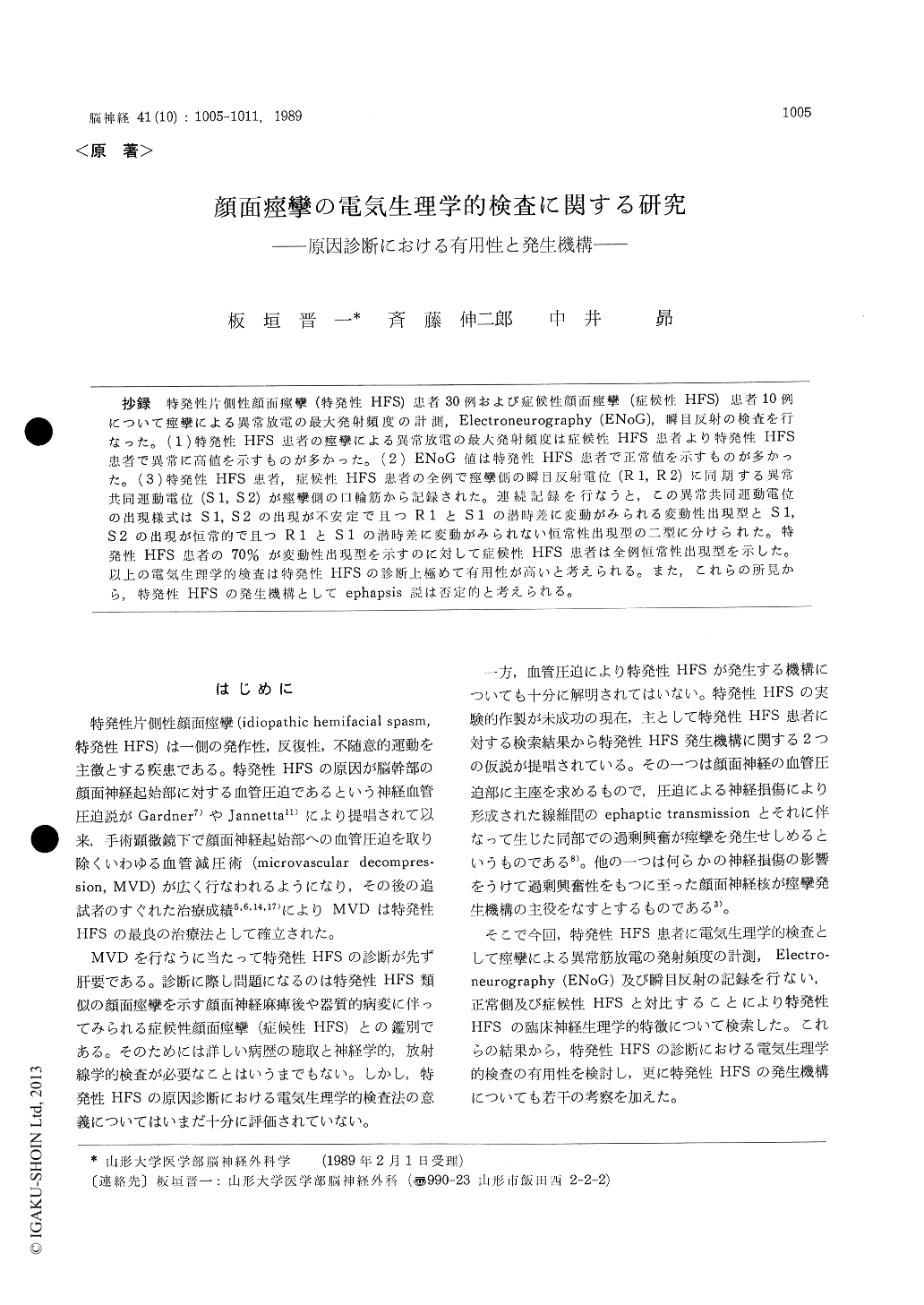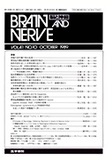Japanese
English
- 有料閲覧
- Abstract 文献概要
- 1ページ目 Look Inside
抄録 特発性片側性顔面痙攣(特発性HFS)患者30例および症候性顔面痙攣(症候性HFS)患者10例について痙攣による異常放電の最大発射頻度の計測,Electroneurography (ENoG),瞬目反射の検査を行なった。(1)特発性HFS患者の痙攣による異常放電の最大発射頻度は症候性HFS患者より特発性HFS患者で異常に高値を示すものが多かった。(2) ENoG値は特発性HFS患者で正常値を示すものが多かった。(3)特発性HFS患者,症候性HFS患者の全例で痙攣側の再瞬目反射電位(R1, R2)に同期する異常共同運動電位(S1, S2)が痙攣側の口輪筋から記録された。連続記録を行なうと,この異常共同運動電位の出現様式はS1,S2の出現が不安定で且つR1とS1の潜時差に変動がみられる変動性出現型とS1,S2の出現が恒常的で且つR1とS1の潜時差に変動がみられない恒常性出現型の二型に分けられた。特発性HFS患者の70%が変動性出現型を示すのに対して症候性HFS患者は全例恒常性出現型を示した。以上の電気生理学的検査は特発性HFSの診断上極めて有用性が高いと考えられる。また,これらの所見から,特発性HFSの発生機構としてephapsis説は否定的と考えられる。
Electrophysiological studies were performed in 30 patients with idiopathic hemifacial spasm (idi-opathic HFS), who underwent microvascular de-compression with abolishment of spasm, and 10 patients with symptomatic hemifacial spasm (symp-tomatic HFS) secondary to Bell's palsy.
( 1 ) The maximum firing rate of abnormal dis-charges recorded from the orbicularis oris muscle during spasm in patients with idiopathic and with symptomatic HFS, and that of discharges recorded on the intact side during voluntary contraction in idiopathic HFS patients measured 181 ± 71 Hz, 68. 4±36. 9 Hz, 56. 3 ± 21. 8 Hz, respectively. Thus, the maximum firing rate of the discharges during spasm in idiopathic HFS patients was exceedingly higher than that in symptomatic HFS patients.
( 2 ) Electroneurography, performed to evaluate quantitatively degeneration of the facial nerve, revealed that the ENoG value (90. 27E16. 5%) in idiopathic HFS patients were higher than that (57. 6±26. 8%) in symptomatic HFS patients.
( 3 ) In blink reflex examined, synkinetic poten-tials (S 1, S 2), synchronous to the potentials con-sisting of the early (R 1) and late component (R 2) in the orbicularis oculi muscle, were recorded from the orbicular is oris muscle on the affected side in all patients with idiopathic and with symptomatic HFS. In sequential recording of blink reflex poten-tials (R 1, R 2) and synkinetic potentials (S 1, S 2), the recording pattern of synkinetic potentials was divided into variable and constant type. In the variable type, synkinetic potentials appeared unst-steadily and the difference in latency between R 1 and S 1 was varied. In the constant type, syn-kinetic potentials appeared steadily and the dif-ference in latency between the two was not varied. The 21 idiopathic HFS patients revealed the vari-able type and the remaining nine patients the constant type. On the other hand, no symptomatic HFS patients disclosed the variable type.
In conclusion, electrophysiological examination was undoubtedly useful for differential diagnosis in patients with hemifacial spasm. Based on neu-rophysiological findings described above, ephaptic transmission may not play a role in pathophysiolo-gical mechanism of idiopathic HFS.

Copyright © 1989, Igaku-Shoin Ltd. All rights reserved.


